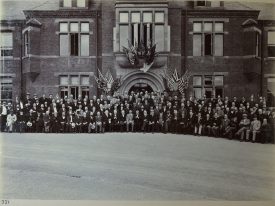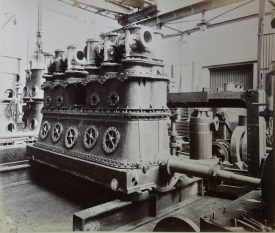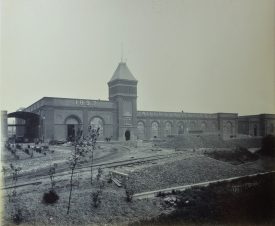The records of a Rugby-based engineering firm that pioneered the manufacture of steam engines and turbines for electricity generation are being catalogued by Warwickshire County Record Office in a project that aims to highlight the importance of the company and its innovations.
The Warwickshire County Record Office has received £50,000 to catalogue and conserve the donated archive of Willans & Robinson and successors at the same works site, including present day occupants Alstom. The funding comes from two main sources, the National Cataloguing Grants Scheme, and the National Manuscripts Conservation Trust in recognition of the exceptional historical importance of this business archive that is not widely known about.
Origins of the firm
The firm began as a partnership between Peter Willans and Mark Robinson in 1880 at Thames Ditton in Surrey, manufacturing high-speed steam engines using Willans’ design for river launches. Willans invented the central-valve steam engine that was crucial to the firm’s initial success but he died in 1892 after an accident, so didn’t see the company expansion that led to the move to Rugby in 1897.
Moving to Rugby
This location was chosen because of the town’s central position in the UK, that had a ready-made workforce skilled in manufacturing and power generation because of the railway industry. Good railway access at Rugby also meant that transporting raw material into the factory and finished goods out was straightforward.
By the time of Willans’ death the company engines were driving almost 70% of the turbines generating Britain’s overall electricity output and demand was coming in from overseas.
Financial difficulties and takeovers
Despite this success and pioneering developments in steam electric locomotives, motorcar parts production, boiler manufacture and steam turbines, the firm struggled with controlling its finances. This led to it being taken over by Dick, Kerr and Company Ltd in 1917, which then became part of English Electric a year later. This saw the name of the site changed to the Willans Works. English Electric came under the ownership of GEC in 1968, which also ran British Thomson-Houston, another power generation company that was also in Rugby. The Willans site now hosts the thermal power division for Alstom, so turbine design and manufacture continues there to this day.
The collection
The collection, deposited in stages between 2006 and January 2014, is known as the Willans Works archive and refers mostly to the Rugby site, but also has important material relating to Thames Ditton. The records cover the period from the 1870s to the early 2000s and include an extensive run of negatives and photographs. Fortunately the log books for jobs carried out by the company’s photographic department have survived so the negatives (many of which are glass plate) can be identified.
The company was the first engineering firm to start in Rugby and was one of the town’s biggest employers with nearly 1,000 people working there. The site is still important for local employment and one of the aims of the project is to show the impact on Rugby and its social history. A blog will keep people up to date with any discoveries and on the progress of the £3,000 fundraising appeal to complete the repackaging and essential conservation work, which is another area where volunteers are assisting. The project will also note Willans & Robinson archive material held elsewhere.
Warwickshire County Council is leading the project with support from Warwickshire Industrial Archaeology Society, Friends of the Warwickshire County Record Office, Rugby Local History Research Group, Rugby Family History Group, the Institution of Mechanical Engineers and others.










Comments
I worked as a photographer for fifty years at Willans and retired in 2002. I carried out the copying of thousands of old 8×10 glass negatives onto film which produced a positive which was then printed to a negative, both of these were then carried the reference number of the original glass negative. The number referred to a log entry which gave a full description of the image. I spent many hours rewriting old log books where the original was falling apart with age. See the new log books with my writing in ink and a navy nib.
Many very old negatives were lost by being stored in a damp air raid shelter due to the lack of space in the X-Ray department where the Photographic Section was located. In 1952 we were not allowed to call ourselves the Photographic Department due to the pig headedness of the head of X-ray Department. who felt that we might break away from him. There is very much more that I could add about my time at Willans English Electric a truly great company lost forever to the French.
Hello Andrew
This is superb information about the Willans Works. You must have many interesting tales to tell us on the subject. We would like you to add to ourwarwickshire some more of your experiences.
We wait in anticipation to hear from you.
During my 50 years at Willans I saw steam turbines grow in size from 20mw up to 660mw 3000rpm and the really huge machines like San- Onofre California USA at 1200mw 1800rpm .
My father came to the Willans Works as an apprentice from London age 18 in 1947, moved on to Whetstone and stayed with them until the late 1980s when he was made redundant. He was a draughtsman I believe and he had a sense of humour, because I have a drawing that would go down well on April 1st using the names of his colleagues. It is so clever I thought at first it was genuine!
My Granddad worked at Willans. My Mum used to go down there every day, and I’d go with her. He’d go with his lunchbox under his arm, he’d roll his sleeves up when he got in, get the carbolic soap, and give his face, his arms a good scrub. I remember the tins at home all full of soap!
All the houses were so dark.
Fascinated with your website. I started here in 1947. You had an admin gent called Cowardine. He came to Ammanford College to lecture and secured six apprentices from there, myself being one of them. Fond memories.
My uncle, George Murdoch, worked in Hydro-electric and was resident in Rugby during the mod-1940s. I think it highly likely that he worked at the Willans works at the time. We have also found out that another member of the family, James BB Murdoch, was resident at ‘The Retreat’ just opposite the works in 1929 and I’m wondering if he had a connection too.
I served a three year City & Guilds Craft Appreticeship at the GEC, Willans Works, from September 1973 until 1976.
In 1975, I was awarded the Foreman’s Shield for most outstanding craft apprentice. I hope the shield is safe somewhere. Not bad for someone who is dislexic and was a secondary school (Harris C of E) drop out. I worked in the Works Services department for two years after that.
Good memories of a wonderful time with lovely colleagues – Des Tarrant, Pat Treacy, Joe Tew, Howard Walters, Ted Pratt, Johnny Diack and not forgetting the workers best boss MD Bob Davidson. Happy days!
Add a comment about this page